


 |
May 21, 2017: A Walking Tour of Berlin |
 |
May 19-20, 2017: We Travel to Berlin |
 |
Return to the Index for Our Visit to Berlin |
We still had a good deal of light this evening, so we thought we would go out and explore our neighborhood. We are on our own this evening, and we will be on our own tomorrow until our four friends arrive late in the afternoon and we move to the hotel where Prudence has extremely generously gotten us a room so we can all be together.
An Orientation to Berlin
Berlin is the capital and the largest city of Germany as well as one of its 16 constituent states. With a population of approximately 3.7 million, Berlin is the second most populous city in the European Union. Located in northeastern Germany on the banks of the rivers Spree and Havel, it is the center of the Berlin-Brandenburg Metropolitan Region (with 6 million residents from more than 180 nations the sixth most populous urban area in the European Union).
|
First documented in the 13th century and situated at the crossing of two important historic trade routes, Berlin became the capital of the Margraviate of Brandenburg (1417–1701), the Kingdom of Prussia (1701–1918), the German Empire (1871–1918), the Weimar Republic (1919–1933) and the Third Reich (1933–1945). After World War II the city was divided; East Berlin was declared capital of East Germany. The West German capital was moved to Bonn, and West Berlin became a de facto West German exclave, surrounded by East Germany. From 1961 to 1989, West Berlin was surrounded by the Berlin Wall, constructed by the Soviet Union and Communist East Germany. Following German reunification in 1990, Berlin once again became the capital of all of Germany.
Berlin is a world city of culture, politics, media and science. Its economy is today based on new, high-tech firms and the service sector, encompassing a diverse range of creative industries, research facilities, media corporations and convention venues. Tourism is also a major economic component. Modern Berlin is home to world-renowned universities, world-class museums too numerous to mention, and a plethora of historic sites- both ancient and modern. Berlin is familiar to most people as it is often used as a location for film and television productions. The city is well-known for its festivals, diverse architecture, nightlife, contemporary arts and a high quality of living; it is a young, cosmopolitan, entrepreneurial city almost without equal.
|
On this map, I have marked a few of the major landmarks and locations we visited as well as the approximate routes of the two long walking tours that we did in the city. On our first full day here, Fred and I spent almost the entire day on a walk from the Hauptbahnof (the Central Train Station, S-Bahn/U-Bahn nexus, and destination in itself), past the Reichstag and the Brandenburg Gate and then eastward through the old East Germany all the way to Alexanderplatz. That's the line in green. On the first full day with Prudence, Nancy, Ron, and Karl, we did another guided walking tour that did take all day; it began at the Reichstag, took in the Brandenburg Gate, and then wandered south through the city, stopping at locations such as the Berlin Wall, the Holocaust Memorial, Hitler's bunker, Checkpoint Charlie and many other places you can visit with us on the page devoted to that day.
Although Prudence walked with us through part of the Tiergarten, Fred and I were the only members of our group to visit the Victory Column and see the incredible views from the top. Our entire group also spent an entire day on a motorcoach tour to Dresden, and five of us also spent a half day in Potsdam. The last major event was a cruise we all took on the River Spreee. You'll be able to go along with us on all these excursions on the subsequent pages.
Our Evening Walk
|
The evening walk Fred and I took tonight, as well as the walks the two of us would take tomorrow around the Hauptbahnof, Reichstag, Brandenburg Gate and Museum Island, would be duplicated with Prudence, Nancy, Karl, and Ron arrived. This means that some of the pictures we took this evening will be duplicated on the page covering tomorrow night. Pictures from the other sites, which Fred and I will visit tomorrow, will also be at least partially duplicated when we visit those same sites with the group in the upcoming days. I might have gathered all the pictures devoted to a given location in the same place, but I concluded that this would lead to convoluted explanations of many of the photos. So, there will be duplicate pictures in this album. Please don't fault me too much if I describe, say, the Kaiser Wilhelm Memorial Church (shown on the aerial view above as "Kaiser Wilhelm Gedachtnis Kirche"), once this evening and again on tomorrow's page. If, as you proceed through the day pages you do find pictures and narrative that seem to show the same thing or retell the same story, feel free to skim forward as you wish.
Hardenberg Strasse
|
Right down by the Zoo Station was this building- Amerika Haus. We all wondered what it was, and we speculated, but it wasn't until we looked it up online that we discovered our speculation to be pretty much true. After World War II, there was a need to provide an opportunity for German citizens to learn more about American culture and politics, and engage in discussion and debate on the transatlantic relationship. Run by the American government until 2006, Berlin’s Amerika Haus is one of many Amerika Häuser located across Germany.
The function and fortunes of the houses waxed and waned over time, although its importance here in Berlin was very different, as West Berlin was isolated amid the sea of East Germany. With the fall of the Berlin Wall, and especially the reunification of the country, the need for a USIA-sponsored information house declined. Part of that was also due to the enthusiastic adoption of American culture in Germany and elsewhere in Europe. In 2006 the Amerika Haus Berlin was officially handed back to the city of Berlin and its doors were closed to the general public- save for the occasional lecture series. Three years ago, the charitable organization "C/O Berlin" took over the building, and it hosts photography exhibitions there. In 2015, C/O Berlin was awarded an architectural prize for its sensitive refurbishment and revitalization of the building.
Here are some of the interesting sights we photographed on our way down the street:
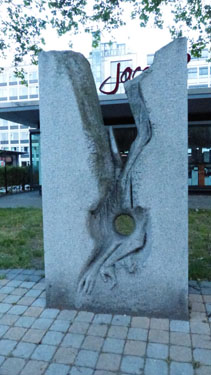 An Interesting Sculpture |
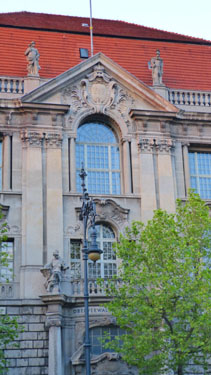 A Building Across the Street |
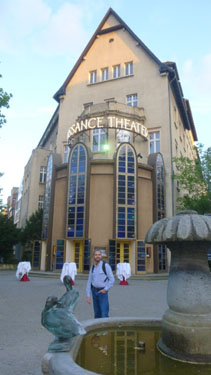 A Neighborhood Playhouse |
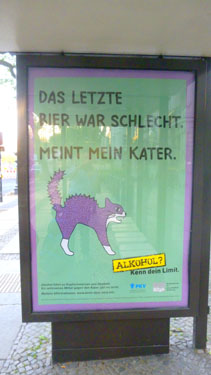 "That last beer was bad; now I have a hangover! Alcohol? Know Your Limit" |
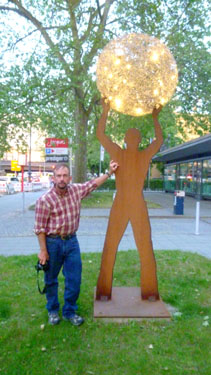 This sculpture was lighted |
Kaiser Wilhelm Memorial Church
|
|
In my picture at the far left, you can see the remains of the old church as well as the new belfry (currently sheathed in a fabric covering to allow renovations to the outer skin). Taken a litter earlier as we walked along Budapester Strasse you can also see the new church building.
|
The foundation stone was laid in 1891 and the church was dedicated in 1895, although portions were not completed for another ten years. The construction cost (6.8 million gold marks worth about $2 million at the time) was obtained primarily through donations. On the night of 23 November 1943, the church was extensively damaged in an air raid, although by no means beyond repair. A remnant of the spire and much of the entrance hall survived intact, as did the altar and the baptistry.
After the war, in 1947, the church foundation decided to rebuild the church, but the manner in which this should be done was contentiously debated until the late 1950s. The winner of the 1956 design competition initially proposed that the remnant of the old spire to be torn down, but that plan provoked a public outcry in which the ruined tower was characterized as the "heart of Berlin". The design was revised to preserve the tower, while most of the remaining structure was pulled down in order to build the modern church that now occupies most of the site. So now there are three major buildings- the new church and new belfry with the old, partially destroyed spire between them.
|
From the church, we continued walking east across the plaza between it and the Europa Center. We could see at the other side of the plaza that there seemed to be a large water feature of some kind, so I made a movie as we walked over to it, and I continued that movie as we had our first look at the Weltkugelbrunnen.
You can watch the movie with the player at left. I do not know why the first few minutes of the movie are out of focus, but just let it play a few seconds and it will clear up.
The Weltkugelbrunnen
|
|
The Weltkugelbrunnen was opened in 1983; there was an open competition for the design of the fountain- a competition won by a Berliner, Joachim Schmettau.
|
|
The operation of the Weltkugelbrunnen costs the district of Charlottenburg-Wilmersdorf around 75,000 euros per year. This is a high cost for the district, so the Weltkugelbrunnen is dependent largely on individual and corporate sponsors.
We found a little cafe down on the lower level where we shared a light snack and a couple of desserts before we continued walking around.
The Europa Center
|
|
After an RAF air raid in World War II on the night of 22/23 November 1943, the building lay in ruins. After the war, the cleared premises were used only intermittently for more than a decade, according to need. Makeshift constructions were used variously by wrestlers, circus performers and missionaries, followed by food outlets and briefly a cinema hosting so-called Sittenfilme ("films of manners"). A local newspaper described the central site as a "stain on Berlin's calling card".
Soon after the construction of the Berlin Wall in 1961, the situation changed. With the reconstruction of the Memorial Church, a committee was appointed to oversee the redevelopment of the Breitscheidplatz' eastern side. He commissioned the architects Helmut Hentrich and Hubert Petschnigg to design and build an office and shopping complex modelled on American malls. Construction work began in 1963, and in April, 1965, the Europa-Center was inaugurated by Mayor Willy Brandt.
The complex today has some 750,000 square feet of floor space divided into distinct units- a two-storey foundation with a basement and two inner courtyards, a cinema, a hotel, an apartment block, and the box-shaped 21-storey high-rise which, when it was constructed, was the highest in Berin. At present there are about 100 shops and food outlets in the Center.
United Buddy Bears
|
|
|
|
"United Buddy Bears" is the international art exhibition of more than 140 of the bears with the motto: "We have to get to know each other better, understand one another better, trust each other more, and live together more peacefully". In the exhibition, the bears promote "tolerance, international understanding and the great concept of different nations and cultures living in peace and harmony". The bears stand "hand in hand" in a "peaceful circle". The first of these displays was in 2002, when the bears were arranged in a circle around the Brandenburg Gate. 35 million people have already attended one of the exhibitions of the colorful United Buddy Bears.
Some Final Pictures from the Breitscheidplatz
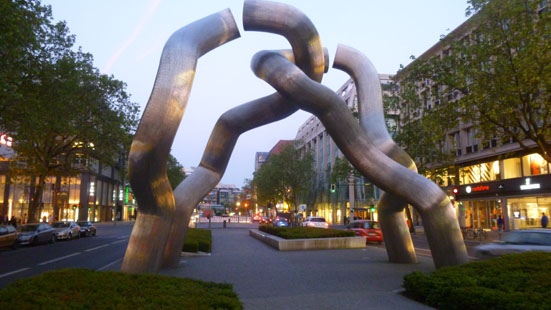 A Sculpture on the Breitscheidplatz |
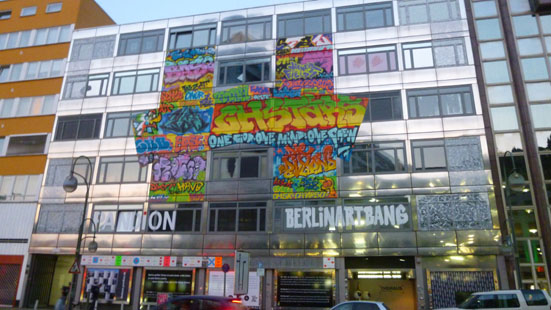 Interesting Graffiti |
We walked back towards the church, heading back to the Wyndham Excelsior.
|
|
What made the building so interesting was the fact that many of the windows in some of the building's tiers were not actually rectangular, but rhomboid (the opposite corners of the rectangle moved slightly off the horizontal and/or vertical). Doing this gives the impression that the side of the building is not vertical but wavy. This could never have been done before curtain wall construction; since the outer sheath is not load-bearing, almost anything can be tacked onto the outside of the steel or reinforced concrete core.
Looking at the building is a little disconcerting because your eye wants to straighten out the window edges, since that is what your eye is used to seeing. This made the building very attractive, both in full light and in the light of the setting sun.
As darkness fell, we headed back to the Wyndham Excelsior for a great night's sleep.
You can use the links below to continue to another photo album page.
 |
May 21, 2017: A Walking Tour of Berlin |
 |
May 19-20, 2017: We Travel to Berlin |
 |
Return to the Index for Our Visit to Berlin |